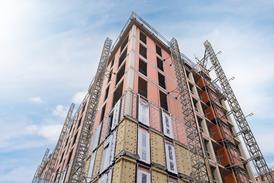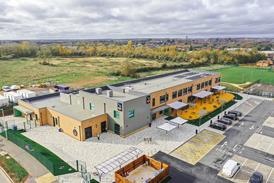The building used for the whole-life cost model is a three-storey office block with a gross floor area of 5900 m2 and a net lettable area of 4480 m2, with office accommodation on the ground, first, second and third floors. The occupational density on which the lift calculation is based is one person per 14 m2 of net office area, and the lift installation is designed to comply with the latest British Council for Offices guidelines for passenger lift installations. The design criteria used for the lift installation is shown in the table below right.
Recent changes in lift design means that there are now a range of lift options available. Three of the more common types have been used for the article:
- Option 1
Side-acting hydraulic passenger lift with oil cooler and electronic valve control - Option 2
Traditional electric-traction passenger lift with roof-mounted machine room - Option 3
In-shaft-driven traction passenger lift. These lifts have all the motors and running gear within the shaft, which means that no machine room is required.
The in-shaft drive machines have gone a long way to providing a cost-effective alternative to hydraulic machines. With ride quality similar to standard traction installations, and capital costs comparable to hydraulic lifts, they are fast becoming the first choice for low- to medium-rise applications.
The main drawback of the in-shaft machines is that they are not currently available in capacities bigger than 13 persons. That said, if the building shape and form means they can be used, there are considerable savings to be made – not only on the capital costs, but also on the costs of running, operating and maintaining it over 25 years. As the cost model will confirm, the in-shaft drive model is 15% cheaper over the life cycle than the hydraulic option, and 30% less than the traditional traction machine.
Readers must note that these results are applicable only to this specific example. If any of the parameters on which the calculations are based change, the results may well be different to those obtained within the cost model. For instance, hydraulic machines become progressively more expensive to maintain over more than five floors, while additional floors and increases in speed and car size will also affect available options and capital costs.
For option three, it is assumed that the omission of the lift motor room (while saving on construction costs) will not necessarily increase the net lettable area of the building.
At a glance
Capital costs The capital costs are based on three alternative installations, designed to exactly the same criteria. Capital costs are shown in the table right and comprise:
- The cost of the new lifts
- Major and minor building works, which include the lift motor room (if applicable), the lift shaft, inserts, steelwork, division screens and shaft scaffolding
- Mechanical and electrical works in connection, including electrical supplies to the lift installation and machine room ventilation (with cooling for the hydraulic option)
- Main contractor's preliminaries, overheads, profit and attendance, and an apportionment of professional fees. The cost of any works to lift lobbies and so on is excluded.
Which lift performs better over 25 years? The whole-life cost for each option has been calculated over a 25-year period and is expressed in terms of its net present value. The life-cycle calculation for each system consists of four primary elements:
- Major asset replacement The replacement of major components (drives and controllers) and the refurbishment of the lift installation after 15 years
- Maintenance Annual comprehensive maintenance, which covers all routine maintenance and replacements, although accidental or other damage is excluded (see graphic)
- Emergency call-outs An allowance for emergency call-outs not covered by the annual comprehensive maintenance policy. There is very little historical data on the actual rate of occurrence for call-outs, so for the purposes of the cost model we have assumed an average of two call-outs per year for each option
- Energy costs The annual cost for electricity consumption, based on the lifts operating at an average of 60 starts per hour to achieve traffic flow.
The discount rate used to calculate the net present value for each element of the life-cycle is once again based on approximately 4%.
Cost analysis
In summary, the in-shaft-driven option offers considerably lower whole-life costs than the other two options. Option 3 offers a 31% lower total whole-life cost than the top-drive traction (option 2), and a 20% saving over the hydraulic option (option 1).
The in-shaft-driven lifts fare particularly well on capital cost. As well as being the cheapest to buy, the omission of a machine room results in considerable savings on building and M&E works in connection with the machine room construction.
Of the two options that require machine rooms, Option 2 is more expensive because it requires a larger machine room than the hydraulic machine. M&E works are more expensive for the hydraulic option because of the need for cooling and ventilation in the hydraulic machine room.
As well as offering the lowest capital cost, the in-shaft lift is also the cheapest to operate over the life-cycle. Lower maintenance costs and smaller energy bills are the main reasons for the in-shaft machine's better performance over 25 years. Of the remaining two options, the hydraulic lift provides the lowest cost over the life-cycle. This is primarily because it has lower maintenance costs than the top-driven traction model, and slightly lower major replacement costs at year 15.
Downloads
Whole-life costs for a three-storey office block
Other, Size 0 kb
Postscript
For further information, contact Cyril Sweett's Andrew Hemsley (consulting division) or Tony Cassidy (engineering services division) on 020-7242 9777. Cyril Sweett would like to thank Ged Smart of Cundall Johnston and Partners for providing engineering assistance, and Rachael Headlam and Mark Disney of Otis for providing technical data, lift-traffic calculations and design and life-cycle cost information.























